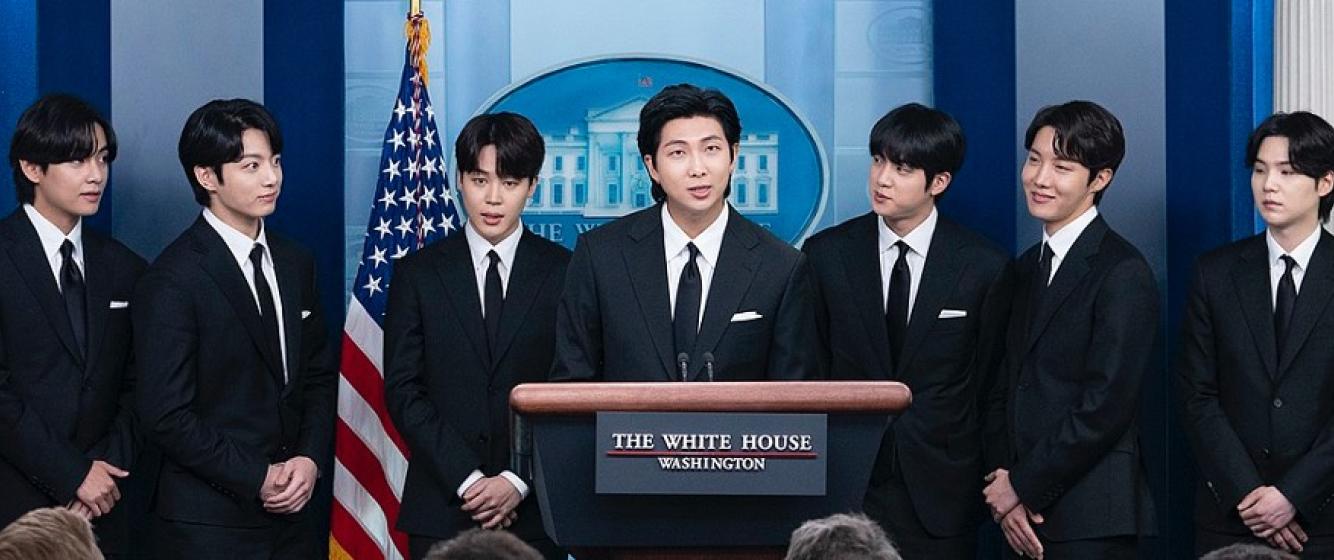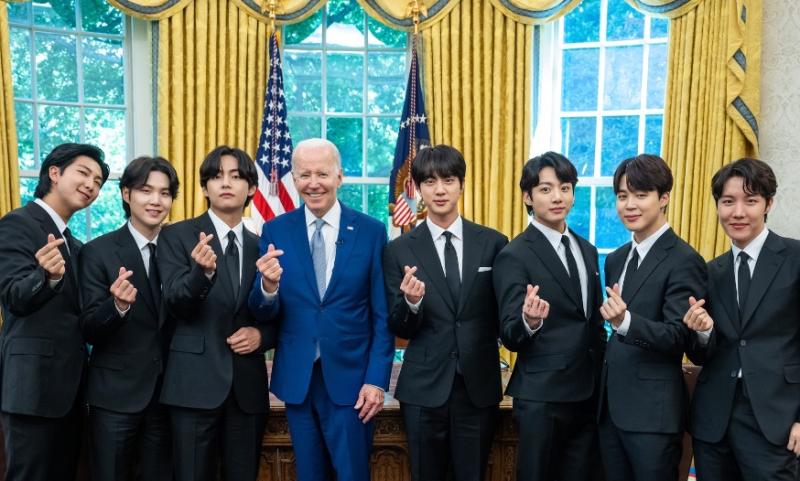
BTS at the White House, May 31, 2022. This group, the most successful K-pop group, started out with songs almost all in Korean and in Japanese. But they later released English songs. This group represents the three languages of the Pop Pacific: Korean, English and Japanese.
Languages of the Pop Pacific (part 1) - Korean
BTS’ visit to the White House in May, 2022 marked another high point in their careers. Having spoken at the UN in 2021, they were now speaking with President Joe Biden about anti-Asian hate crimes in the US for Asian American-Pacific Islander Month. This K-pop group represented the mishmash of languages in the “Pop Pacific,” a world where youth on both sides of the Pacific enjoy the same music via YouTube or social media. When asked what makes K-pop “Korean” most people will say that the songs are made in Korea, by Koreans, and sung in Korean. Yet many K-pop singers are non-Korean and almost all songs use English.
BTS reflects the “Pop Pacific” transnational sphere. They have released their songs in Korean, English, and Japanese. The bulk of their earlier songs used mostly Korean lyrics or in releases for Japan, in Japanese. However, their English-language or mixed English-Korean songs became global and US smashes. Six of their English or Korean-English hybrids, starting with “Dynamite” (2020) hit #1 on the Billboard Hot 100 chart. These songs along with their Korean-English hybrids “Life Goes on” (2020) and Take Two (2023) also hit #1 worldwide outside the US (on the Billboard “Global Excluding. U.S. chart”), the only act in history to hit no. 1 on this chart every single year since its inception in 2020.
So once again, “what is K-pop”? If it is not the nationality of the singers, or the training system (which was heavily influenced by American and Japanese training systems), or the sound (indistinguishable from western pop), then perhaps it is the Korean language? As Billboard magazine asked “Does language choice matter, or is it simply a tool to expand and reach more fans as a greater cultural movement evolves?” The term “K-pop” no longer represents a coherent category, since there are so many styles of K-pop, and more importantly, so many non-Korean languages in K-pop. It seems that three official languages have coalesced in the Pop Pacific: Korean, English, and Japanese. All this forms what I call “K-culture,” a highly Americanized version of Korean culture geared for world export. In this post, we will examine Korean, the prestige language of K-pop.

The word "Hangul", written in the Korean alphabet
The use of Korean in K-pop
Historically, even within the Korean peninsula, there was official ambivalence towards the Korean language. King Sejong commissioned and announced the hangul phonetic script in 1446, an event celebrated as a national holiday in Korea every October 9 as Hangul Day. While commoners gradually took up the use of the new script, Joseon-era elites continued to write in Chinese script (hanja), and hangul only entered official use in the late 19th century. In the 20th century, the Korean language in the media was suppressed, during the time of Japanese rule (1910 - 1945). While the official Japanese policy was to assimilate Koreans as (second-class) Japanese citizens, the colonial government allowed some Korean language media in response to Korean nationalist protests of March 1, 1919. The Japanese government used the start of radio broadcasting in Korea in 1927 as a means to spread Japanese information to the populace, but to do so, they needed to broadcast in Korean. Contrary to the goals of the Japanese, Korean nationalists used these broadcasts to promote Korean songs and culture. But during the wartime years, the Japanese government accelerated their policy of forced assimilation. By 1940, the Japanese had banned the use of the Korean language in schools, government, and media, and heavily pressured Koreans to change their names to Japanese names.
With liberation from Japanese rule in 1945, Koreans finally gained control of their own language. However, Korea saw a new flood of language influences from a new country - the United States, which had bases in Korea. A flood of English influences came in from American Forces Korea Network (AFKN) broadcasts. This laid the foundation for English as the language of the pop pacific. In fact, even the name of the genre K-pop is an English word, introduced in 1999, in Billboard magazine by Cho Hyun-jin, to describe Korean popular music.
At first, early K-pop songs were almost devoid of English words and lyrics because K-pop was first developed for the domestic Korean market. A quick look at early K-pop songs shows this trend.
| Language of song title | Total words | Korean words | % Korean words | |
| Nan Arayo (“I know,” 1992) by Seo Taiji and Boys | Korean | 143 | 143 | 100% |
| Ibam-ui kkeut-eul japgo (“Holding on to the End of Tonight,”1995) by Solid | Korean | 130 | 130 | 100% |
| Chodae (“Invitation,” 1998) by Uhm Jung-hwa | Korean | 134 | 134 | 100% |
| Gangnam Style (2012) by Psy | Korean | 297 | 236 | 79.4% |
The first K-pop song, “Nan arayo” (“I know,” 1992) by groundbreaking Seo-Taiji and boys, contained NO English lyrics.
The equally influential“Ibam-ui kkeut-eul japgo (''Holding on to the End of Tonight,”1995) by the Korean American R&B trio Solid, was entirely in Korean even though Solid was known for its American sound.
Uhm Jung-hwa, known as the “Korean Madonna” also sang almost entirely in Korean, as seen in her song “Invitation” (초대, 1998) with just a few lines of a rap in English.
Even in Psy’s viral worldwide hit “Gangnam Style'' (2012), meant to be a satire of Korean status seeking, the only English lyrics were “Hey Sexy Lady” and “Gangnam Style” (with Style being a Korean loanword pronunciation of “style”)
But with the marketing of K-pop to the non-Korean market by the 2000s, and the English language filtered into K-pop songs. Consider these recent hits.
| Language of song title | Total words | Korean words | % Korean words | |
| Run BTS/darryeora bangtan by BTS (2022) | English and Korean | 613 | 276 | 45.0% |
| Fearless (2022) by Le Sserafim | English | 390 | 228 | 58.4% |
| Case 143 (2022) by Stray Kids | English | 563 | 236 | 41.9% |
| Love Dive (2022) by IVE | English | 363 | 110 | 30.3% |
| Super shy (2023) by New Jeans | English | 402 | 55 | 13.7% |
By 2023, the use of English has become so dominant in K-pop that fans are complaining that there is too much English in K-pop songs. But look at this from the “glass half full” perspective: a substantial portion of most K-pop songs are still in Korean. With only 80 million native speakers, Korean is a tiny language by world standards. And yet, Korean language learning has rapidly gained in popularity worldwide, reflecting the craze for K-pop and Korean dramas. CNN pointed out in a 2023 news report that Korean was one of the fastest-growing languages in the world, outpacing Chinese in many areas. In fact, in 2022, learning app Duolingo reported Korean as the seventh most-studied language, and the second most studied Asian language only slightly behind Japanese.

President Joe Biden and BTS making finger hearts in 2022.
Korean: the language of prestige in K-pop
Korean language and culture still plays an important role in K-culture because it adds an aura of cool to K-pop songs. Just like how an opera sounds “right” when it is sung in Italian rather than French, Spanish, or English, a K-pop song sounds right only when it is sung in Korean, or at least has Korean words strewn through it. Without Korean language, K-pop songs sound just like their English-language counterparts.
Korean culture plays an outsized role in defining K-pop. Fans gain prestige by being able to converse in elementary Korean or being able to explain elements of Korean culture like the “finger heart” (index finger and thumb forming a mini-heart). Hangul is used to signify something is “Korean” which makes it cool. Consider the BTS meal which was brought up in an earlier post. Consisting of Chicken McNuggets, Diet Coke, and french fries along with chili sauce and cajun sauce, it became Korean because of the hangul printed on the packaging. Also, the Korean domestic market is still important for a K-pop group. Those groups that draw substantial international fans (BTS, BLACKPINK, TWICE) are still rare in the K-pop world . Thus, it is still important for K-pop performers to appear on Korean music shows and speak in Korean. And often once they become popular in Korea they can become popular internationally, due to how K-pop fans worldwide watch translated versions of the idol shows.
BTS, probably the most successful K-pop group overseas as of 2023, shows the symbolic power of Korean language and culture in marketing K-pop. They are different from other K-pop groups in that there are no American members, and prior to international fame, only RM, the leader of the group spoke English (which he supposedly learned from watching the TV series Friends). Unlike other groups, most of their songs are in Korean, with very few English lyrics. Although their stage names are in English, their fans (known as the “Army”) refer to them by their Korean names (RM is referred to as “Namjoon”). And in their solo careers, members regularly speak in Korean even on non-Korean television shows.
The rise of Korean as a prestige language has accompanied the rise of the K-pop industry worldwide. While Korean gives K-pop a different feel from American songs, it is English that is the actual “official” language of K-pop, and for the Japanese market, it is Japanese versions of song releases. English, as we shall see in the next post, now binds the K-pop audience, with Korean being relegated to a mostly symbolic language, to keep the song “Korean”.
Discussion Questions (instructors may want to play the videos on this blog)
- What are the three “official” languages of the “Pop Pacific” as discussed in the article?
- Why might K-pop no longer be considered ‘just Korean pop’ based on language use?
- What was the huge change in the use of Korean in K-pop from the 1990s to today? What evidence does the blog post show?
- Why is Korean still used in K-pop when so much of its audience doesn’t understand Korean?
- What does the blending of Korean, English, and Japanese in K-pop tell us about language and identity in global pop culture?
Add new comment